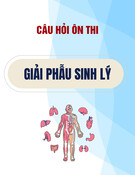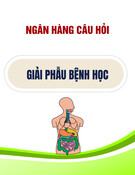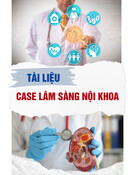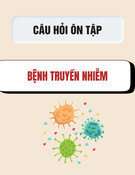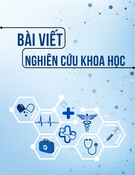
JOURNAL OF 108 - CLINICAL MEDICINE AND PHARMACY Vol. 19 - Dec./2024 DOI: https://doi.org/10.52389/ydls.v19ita.2511
60
Acute respiratory distress syndrome secondary to fat
embolism syndrome: A case report
Ngo Dinh Trung, Nguyen Thai Cuong, Nguyen Thanh Binh,
Nguyen Thi Thu, Nguyen Tai Thu, Do Van Nam,
Nguyen Chi Tam, Le Nam Khanh, Dao Trong Chinh,
Dao Thi Thuy Ngoc, Nguyen Hai Nam and Ho Nam*
108 Military Central Hospital
Summary
Fat embolism syndrome is a rare syndrome typically described after closed long bone fractures.
Acute respiratory distress syndrome is a feared complication of fat embolism syndrome. We present a
case of a 17-year-old teenager who developed acute respiratory distress syndrome with fat embolism
due to traumatic fractures of the left femur and tibia after a traffic accident. This report has highlighted
that acute respiratory distress syndrome is a life-threatening complication of fat embolism syndrome
and the most common cause of morbidity or mortality. Supportive care for acute respiratory distress
syndrome to minimize lung damage from fat embolism syndrome is vital.
Keywords: Fat embolism syndrome, acute respiratory distress syndrome, femur fractures.
I. BACKGROUND
Fat embolism (FE) is defined as the presence of
fat globules in the pulmonary or peripheral
circulation, and fat embolism syndrome (FES) refers
to the clinical symptoms that follow an identifiable
insult1. FES is a rare but serious medical condition
that German pathologist Friedrich Albert von Zenker
first described FES in 18612. FES is most often
associated with long bone fractures, particularly of
the femur, and orthopedic surgery1. In one of the
largest clinical studies, using Gurd criteria3 27 cases
of FES were identified from 3,000 patients with long
bone fractures with an incidence of 0.9%. Mortality
rates are estimated to be between 5% and 20%4. The
most common cause of morbidity or mortality
includes acute respiratory distress syndrome (ARDS).
We present a case of a 17-year-old teenager who
developed ARDS with FES due to traumatic fractures
of the left femur and tibia after a traffic accident.
Received: 18 January 2024, Accepted: 12 June 2024
*Corresponding author: honam94qy@gmail.com -
108 Military Central Hospital
II. CASE PRESENTATION
A 17-year-old male teenager with a normal past
medical history presented to our Emergency
Department of 108 Military Central Hospital in
Vietnam after two hours in a traffic accident. On
initial assessment, the patient was stable
(temperature of 36.5°C, respiratory rate of 18bpm,
saturation of peripheral oxygen (SpO2) 98%, heart
rate 106 beats/per/min, blood pressure
110/60mmHg. He had a normal neurologic
examination without focal symptoms and an initial
Glasgow coma scale of 15. There were no chest or
abdominal upon initial imaging workup, and the
head computed tomography (CT) scan was normal,
chest X-ray was normal with no cardiomegaly and
no broken ribs (Figure 1). X-ray of femur and tibia
had a fracture of the upper third of the left femur
and the middle third of the left tibia (Figure 3, 4). He
had a white blood cell count of 26.46G/dL,
neutrophils of 71.1%, red blood cell count of 5.02
(T/L), hemoglobin of 142 (g/l), platelet count of 368
(G/l). At 14th hours of admission, the patient
presented with mild dyspnea, with an increase in

























